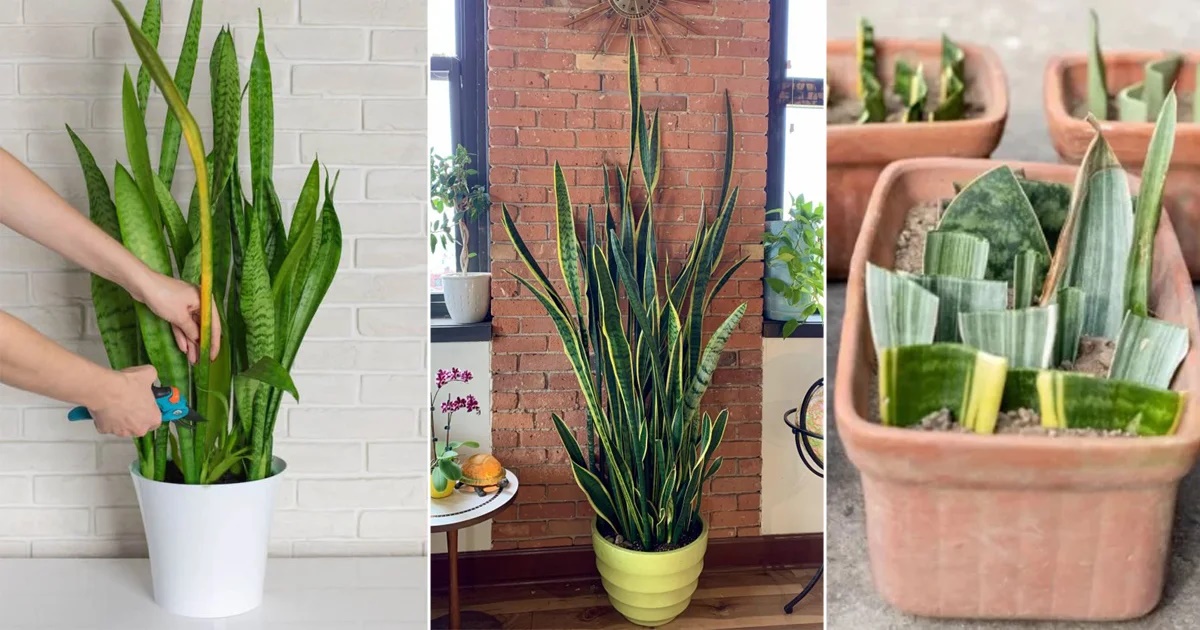
How to Make a Snake Plant Fuller and Bushier with More Leaves
Are you looking for some out-of-the-box ways to Make a Snake Plant Fuller and Bushier? Well, you are up for a bushy treat! Keep reading!
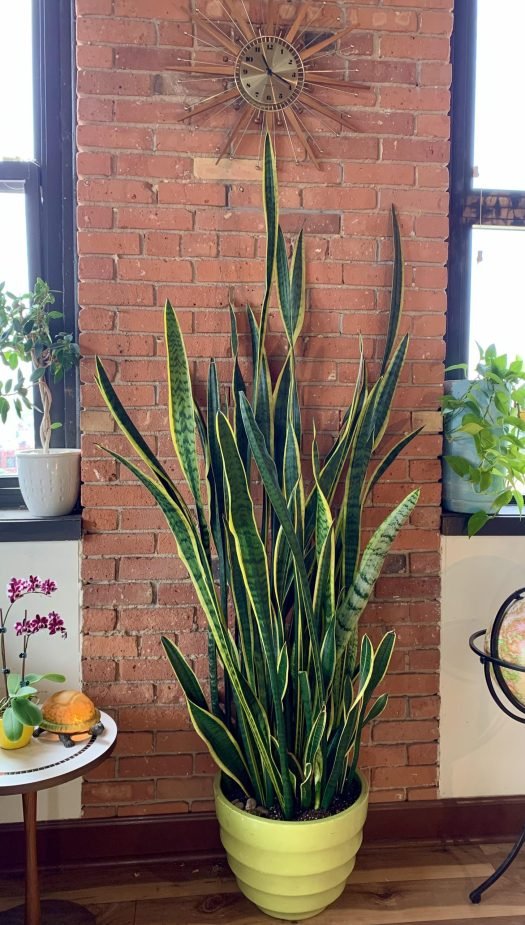
Snake plants are the “marathon runners” of the plant world—they require minimal care and still thrive remarkably well. But, like all plants, they can also have hard days where you can find them struggling to be bushy. If you’re wondering how to Make a Snake Plant Fuller and Bushier, this article is your go-to guide.
Here are some top tips on growing fuller petunias
Tips on How to Make a Snake Plant Fuller and Bushier
1. Keeping the Plant on the Drier Side: Less is More
Stick to a “less is more” approach and water only when the soil is dry. Overwatering is the fastest route to root rot, which will definitely not make your plant fuller.
By keeping your snake plant on the drier side, you mimic its natural habitat, encouraging it to grow more leaves during the “rainy season” and conserve energy during the “dry season.”
When a snake plant experiences dry soil conditions, it produces root hormones called “auxins.” These auxins signal the plant to put more energy into root growth. Once the roots are well-developed, the plant shifts its energy back to leaf production. So, a drier period followed by adequate watering can “trick” the plant into accelerating leaf growth.
Pro Tip: Place a couple of ice cubes on the soil; they’ll melt slowly, ensuring consistent but moderate soil moisture. The slow-drip technique mimics natural rainfall, fostering a more robust root system.
2. Ideal Sun Exposure: Let There Be Light

Snake plants thrive in indirect light, which means bright but diffused light. Direct sunlight can scorch the leaves, leading to stress and reduced growth. On the other hand, low light conditions slow down the photosynthetic rate, thereby stunting leaf production.
Snake plants respond to changes in light duration, a phenomenon known as “photoperiodism.” By manipulating the duration of light exposure, you can trick the plant into believing that the growing season has changed, prompting it to focus on producing more leaves.
Rotating the plant every week can help it get uniform light exposure on all sides, ensuring even growth and a fuller appearance. Consistent rotation avoids the “lopsided” look, where one side of the plant grows more leaves than the other.
Pro Tip: Full-spectrum LED lights can mimic natural sunlight more effectively than traditional artificial lighting. You can try them to provide a more natural light source for your snake plant.
Can a Snake Plant Live Outside? Find Out!
3. Proper Fertilization: Feeding them Right
Proper fertilization should be in sync with the snake plant’s natural growing season. It stimulates the plant to produce more leaves, as it “thinks” the conditions are ideal for growth.
Do remember that feeding the plant frequently is the key here, and the best way to do it, is to dilute the fertilizer to 1/4 of its recommended strength, and feed the plant every 2-3 weeks. This ensures the plant gets a steady supply of nutrients regularly, helping it produce more leaves.
4. Pruning When Needed: The Cut Magic
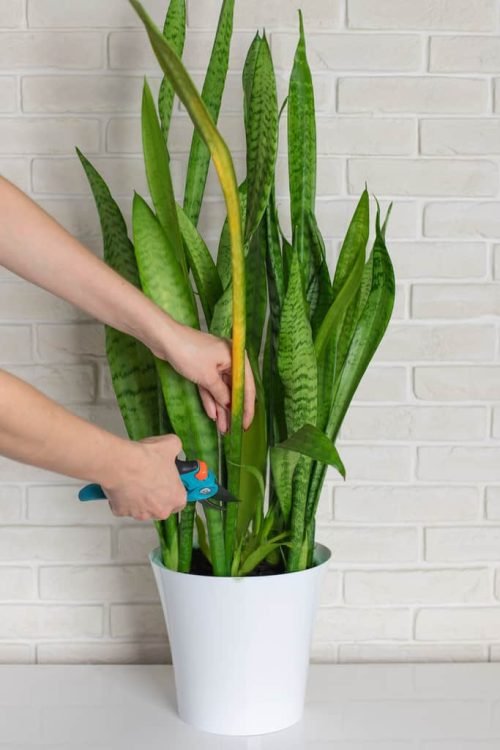
Pruning might appear counterintuitive when your goal is a fuller plant with more leaves.
When you prune a snake plant, you’re affecting its hormonal balance. Specifically, pruning impacts the concentration of growth hormones like auxins and cytokinins. Cutting older leaves changes the auxin-to-cytokinin ratio, encouraging the plant to focus on new leaf growth.
Look for yellowing leaves, signs of disease, or damaged leaf tips as indicators that your plant could benefit from pruning. Prompt removal of these problem areas can free up energy for more leaf growth.
Check out details about black dragon snake plant here
5. Division: Grow Them More!
By dividing a snake plant, you’re redistributing its energy resources. Each new section now has access to nutrients and room to grow, which encourages new leaves to sprout more quickly.
Dividing a snake plant and then planting the divisions in the same pot can create the illusion of a bushier, fuller plant. The divisions will grow simultaneously, filling out the pot quickly and giving the appearance of a single, lush plant – provided the pot is not overcrowded.
6. The Hairpin Technique: The Power of Leaves
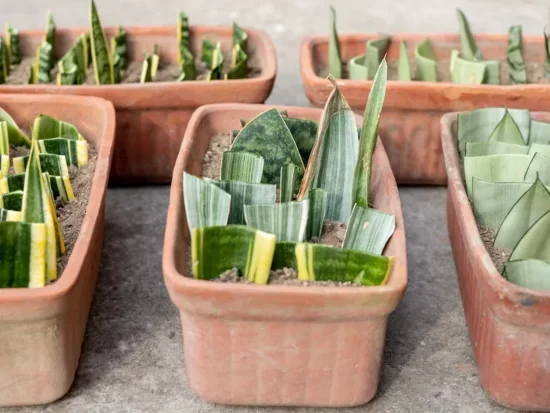
For a bushier look, employ the hairpin technique. Take a fallen leaf or a leaf you’ve pruned and pin it back into the soil using a hairpin. The leaf will sprout roots and add density to your plant arrangement.
7. Growing Multiple Plants in the Same Container
One innovative yet budget-friendly way to maximize the visual impact is by planting multiple snake plants in the same container.
Instead of buying a large, mature snake plant, you can purchase smaller, more affordable young plants. When planted together, they can mimic the appearance of a bigger, bushier specimen at a fraction of the cost.
- Choose a pot that is wide enough to accommodate multiple plants. A 14-16 inches tall and wide container will be good for 2-3 plants. Ensure it has good drainage to prevent water-logging.
- Place the plants in a way that allows them to spread their leaves without overlapping too much. This ensures that each plant gets its share of light and air.
- Keep an eye on the plants to ensure they are growing at a similar rate. If one plant starts to overshadow the others, consider pruning to maintain balance.
Find out all the differences between aloe vera and snake plants here
8. Do Not Go for Large Pots
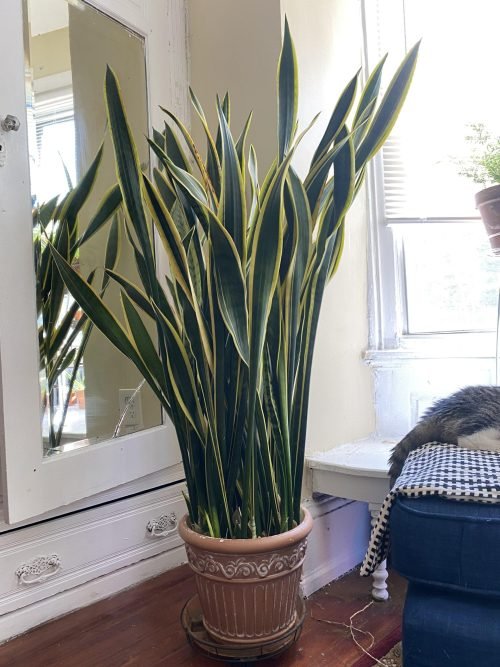
Being slightly root-bound places mild stress on the snake plant, which can act as a growth trigger. When the roots fill up the pot, the plant focuses less on vertical growth and more on producing new leaves and spreading out, making it look denser and bushier.
The result is a bushier plant rather than a taller, lanky one.
- Opt for a pot that’s not too large for the snake plant. One size bigger than the root ball of the plant is just right. Excessive space can lead to overwatering issues and reduced stress signals that stimulate growth.
- While slight root-binding is beneficial, an extremely root-bound plant can suffer from nutrient deficiencies and poor health. If you notice a decline in plant health, it may be time to repot.
9. Epsom Salt Spray: The Miracle Agent
Make a dilute solution of Epsom salt and water and spray it on the leaves. Epsom salt contains magnesium, which is beneficial for leafy plants like the snake plant. It stimulates lush growth and intensifies green coloration.
Doing it once in 4-5 weeks, after diluting one tablespoon of Epsom salt in a gallon of water.
10. Sonic Growth Boosters: The Sound Waves Effect

Research suggests that certain frequencies of sound waves can stimulate plant growth by promoting efficient nutrient and water uptake.
Playing classical music or nature sounds near your snake plant for a few hours each day could encourage more vibrant growth. Just remember to keep the volume moderate so as not to stress the plant.
Do snake plants need drainage holes in the pot? Find out here
11. Touch Therapy: The Power of Physical Interaction
Some studies suggest that gentle touch can stimulate specific growth responses in plants. The theory is that touch triggers a defensive response that can lead to thicker, bushier growth.
A gentle touch or stroke along the leaves once or twice a day could stimulate growth responses. Don’t overdo it; too much touch could induce stress.
12. Gently Bending Its Leaves: Letting it Spread
When you gently bend snake plant leaves, it encourages the plant to grow more horizontally or outward rather than solely in an upright fashion.
By encouraging lateral growth, you can create a fuller and more visually appealing appearance, as the leaves will spread out and cover more space.
- As the snake plant leaves grow outward, they can create the illusion of a bushier plant. This technique can help fill in empty spaces within the plant, making it look denser and more lush.
- Gentle bending can enhance the overall aesthetics of the snake plant, making it appear more balanced and visually pleasing.
- It can also make the plant look healthier and well-maintained.
